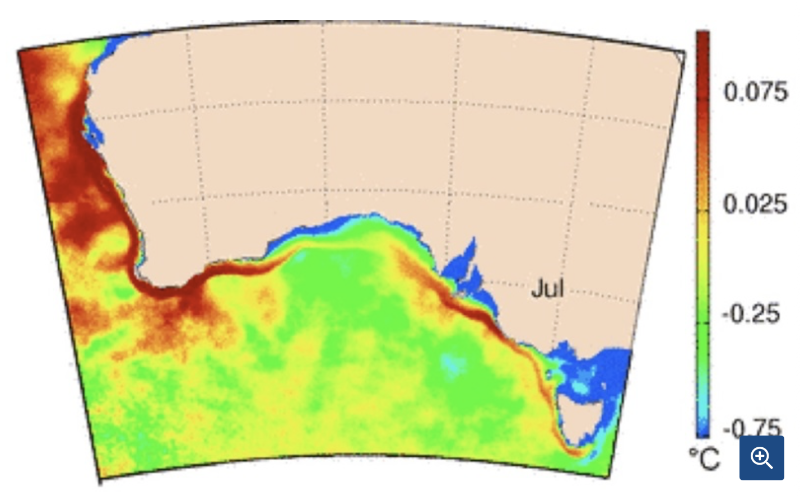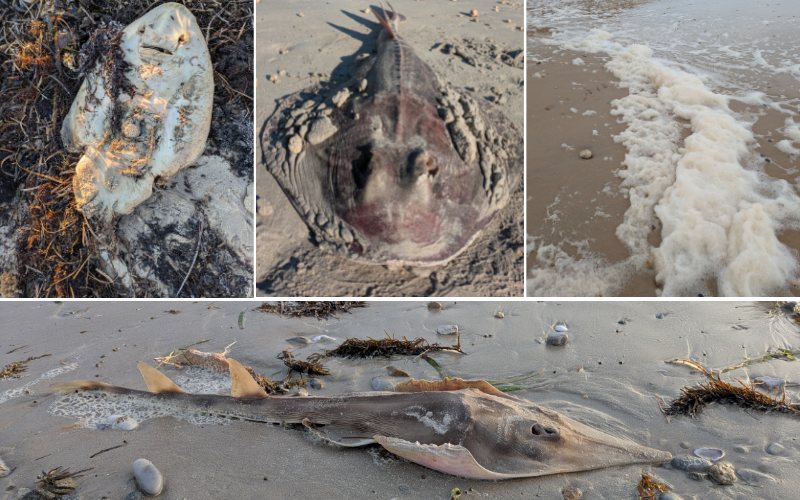Fishermen despair and beach-walkers recoil as blue algae bloom devastates South Australia’s marine life. It is now a national issue as Senate inquiry kicks off, Rex Patrick reports.
In mid-May, I visited Port Vincent on the east coast of York Peninsula for a bit of rest and relaxation. I’m an early riser, and sunrise over Gulf St Vincent can be exquisite. This morning I was fascinated to see what looked like a Fiddler Ray swimming about the beach. How remarkable, I thought.
But by evening, my thoughts had changed as it was apparent that there were a number of these fiddlers beaching in distress.
In May, the politics of the algae bloom were relatively quiet and local. The politics in July are deafening and becoming a national story.
A massive algae bloom has since spread to more than 4,500 square kilometres of SA water – from the Coorong, to the waters off Adelaide, up to the head of Gulf Saint Vincent, and now spreading into Spencer’s Gulf. More than 400 different species of marine life have been killed off or died as a result of the algal bloom – sharks, seals, rays, crustaceans and fish. It’s even killed kangaroos.
Political bloom
On Monday this week, Federal Environment Minister Murray Watt visited Adelaide and announced $14M in funding to help SA deal with the bloom. He described it as devastating, but refused to declare it a ‘national disaster’. There are legal technicalities, apparently, that meant he had to be careful with his words.
On Tuesday, SA Premier Peter Malinauskas, belatedly amped up and in open contest to his federal colleague, did call it a ‘natural disaster’. Three senators, Senators Cadell (Nationals), Grogan (Labor) and McLachlan (Liberal), foreshadowed in the Senate an intention to initiate a broad inquiry on ‘The causes, frequency, scale and duration of recent algal blooms in South Australian marine and coastal environments’.
On Wednesday, the bloom became part of the first debate in the Senate of the 48th Parliament as the Australian Greens’ Environment Protection and Biodiversity Conservation Amendment (Climate Trigger) Bill was discussed. In the late morning, at Senator’s statements, SA Federal Senator Wong, who rarely makes such statements, did a five-minute speech on the bloom.
By evening, the Senate agreed to support the Inquiry mentioned the day before.
Those ‘in the know’ now know that the bloom isn’t going away. Whilst the intensity of the bloom has peaked (for the moment), the marine devastation has just commenced.
Caused by climate change
The cause of the bloom is global.
This year, the warming Leeuwin Current that runs along the Western Australian coast spilled around the bottom left-hand corner of the country and across the Great Australian Bight to the coast of SA.

Leeuwin Current Warm Water (narrow red band) flowing to SA (CSIRO)
Warming water mixed with nutrients flowing from the mouth of the River Murray, and the bloom formed. The first areas to experience the bloom were Victor Harbour south of Adelaide and the Coorong.
The bloom spread, and there was hope that lowering water temperatures would eventually disperse and stop the bloom. But one of the regular water-cooling events, the ‘Bonney upwelling’, hasn’t been quite as regular this year.
Most blooms in coastal waters last only a few days to a month. Some can last longer. Karenia Mikimotoi, the main offender in this SA bloom, can produce compounds whereby its associated blooms last 3 to 4 months.
But it is possible for these blooms to persist for as long as 18 months. And that’s where this is almost certainly going.
Fiddlers in the Bay
‘Canary in the coal mine’ is an idiom meaning ‘an early warning of danger’. We need a new water idiom, perhaps ‘fiddler in the bay’.
The politics on the algae bloom have ramped up because it is likely that it will be long-lasting. It’s likely to linger in its current location but also move up the Spencer Gulf to devastate the remainder of SA’s seafood industry (even if it doesn’t, South Australians are already looking to buy interstate or foreign seafood as a matter of precaution) and may reach and devastate cuttlefish near Whyalla. Tourism is set to suffer too.
The SA Government has matched the $14M of federal funding announced on Monday to tackle the toxic algal bloom outbreak. I don’t want to throw cold water on that funding, but it’s not going to throw cold water on the coastal waters of SA.
This bloom is a result of climate change. Coral bleaching on the Great Barrier Reef and toxic algae blooms on our southern coasts are all part of the bigger picture. As David Attenborough’s latest and perhaps most important documentary, Ocean, shows, our oceans are vital to the environmental health of the planet, and the demise of marine creatures is often the harbinger of trouble.
For too long we’ve taken the vastness of the deep for granted.
Whilst it is true that Australia can’t tackle climate change alone, it must show leadership in pursuit of a global response. Approval of fossil fuel projects in the last parliament, and the extension of the North West Shelf project in this parliament, don’t help and don’t lead. Too often, governments talk the talk on the environment, but their actions tell a very different story.
The $28M funding will not stop the current bloom. It will not stop the next bloom. That will require much more significant action.
Rex Patrick is a former Senator for South Australia and, earlier, a submariner in the armed forces. Best known as an anti-corruption and transparency crusader, Rex is also known as the "Transparency Warrior."

